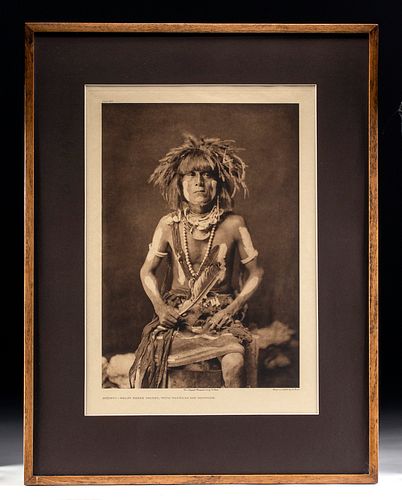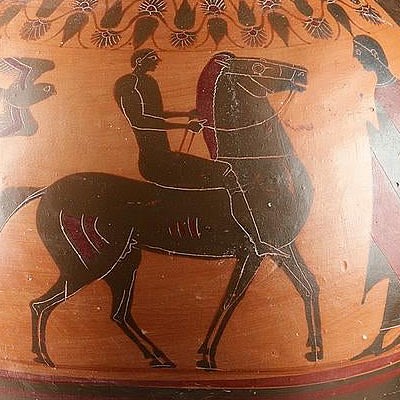Edward Curtis Photogravure - Snake Priest, 1921
Lot 159
About Seller
Artemis Gallery
686 S Taylor Ave, Ste 106
Louisville, CO 80027
United States
Selling antiquities, ancient and ethnographic art online since 1993, Artemis Gallery specializes in Classical Antiquities (Egyptian, Greek, Roman, Near Eastern), Asian, Pre-Columbian, African / Tribal / Oceanographic art. Our extensive inventory includes pottery, stone, metal, wood, glass and textil...Read more
Categories
Estimate:
$3,000 - $6,000
Absentee vs Live bid
Two ways to bid:
- Leave a max absentee bid and the platform will bid on your behalf up to your maximum bid during the live auction.
- Bid live during the auction and your bids will be submitted real-time to the auctioneer.
Bid Increments
| Price | Bid Increment |
|---|---|
| $0 | $25 |
| $300 | $50 |
| $1,000 | $100 |
| $2,000 | $250 |
| $5,000 | $500 |
| $10,000 | $1,000 |
| $20,000 | $2,500 |
| $50,000 | $5,000 |
| $100,000 | $10,000 |
| $200,000 | $20,000 |
About Auction
By Artemis Gallery
Jun 4, 2020
Set Reminder
2020-06-04 10:00:00
2020-06-04 10:00:00
America/New_York
Bidsquare
Bidsquare : Exceptional Antiquities, Asian, Ethnographic
https://www.bidsquare.com/auctions/artemis-gallery/exceptional-antiquities-asian-ethnographic-5185
An important one-day auction featuring museum-worthy examples of Egyptian, Greek, Roman, Etruscan, Near Eastern, Far East / Asian, Pre-Columbian, African / Tribal, Oceanic, Native American, Spanish Colonial, Russian, Fossils, Ancient Jewelry, Fine Art, so much more! Artemis Gallery info@artemisgallery.com
An important one-day auction featuring museum-worthy examples of Egyptian, Greek, Roman, Etruscan, Near Eastern, Far East / Asian, Pre-Columbian, African / Tribal, Oceanic, Native American, Spanish Colonial, Russian, Fossils, Ancient Jewelry, Fine Art, so much more! Artemis Gallery info@artemisgallery.com
- Lot Description
Edward Sheriff Curtis (American, 1868-1952). "Honovi Walpi Snake Priest with Totokya Day Painting" published in The North American Indian (1907-1930) Portfolio XII, Plate 408 (Van Gelder) - from copyright photograph 1921 by E.S. Curtis, photogravure Suffolk Eng Co Boston. A mesmerizing portrait of Honovi Walpi Snake Priest demonstrating American photographer Edward Curtis' artistry as well as his ethnographic intent. The sitter is presented seated and directly facing the viewer - with body paint, elaborate jewelry, and a dance costume that includes a woven fringe belt holding a leather pouch and a feather whip. This portrait was part of Edward Curtis' epic 20 volume project to document Native Americans threatened by Westward expansion in the United States entitled "The North American Indian" (1907-1930) - a masterwork that experts have estimated would cost more than $35 million to create today. Size: 18" L x 12.5" W (45.7 cm x 30.5 cm); size of frame: 24" L x 19" W (61 cm x 48.3 cm)
To learn more about Curtis' impressive undertaking, please read Gilbert King's article in Smithsonian Magazine. It opens as follows, with King brilliantly capturing Curtis' urgency and steadfast work ethic to document the indigenous peoples before expansion would potentially eclipse their cultures, "Year after year, he packed his camera and supplies—everything he’d need for months—and traveled by foot and by horse deep into the Indian territories. At the beginning of the 20th century, Edward S. Curtis worked in the belief that he was in a desperate race against time to document, with film, sound and scholarship, the North American Indian before white expansion and the federal government destroyed what remained of their natives’ way of life. For thirty years, with the backing of men like J. Pierpont Morgan and former president Theodore Roosevelt, but at great expense to his family life and his health, Curtis lived among dozens of native tribes, devoting his life to his calling until he produced a definitive and unparalleled work, The North American Indian. The New York Herald hailed as 'the most ambitious enterprise in publishing since the production of the King James Bible.'" ("Edward Curtis’ Epic Project to Photograph Native Americans" by Gilbert King - Smithsonian Magazine March 21, 2012)
While Curtis has had his critics who have claimed that he romanticized the natives' existence, others have argued that he was ahead of his time and depicted them with dignity and respect. In her book entitled, "Shadow Catcher: The Life and Work of Edward S. Curtis" (Bison Books, 2005) Laurie Lawlor wrote, "When judged by the standards of his time, Curtis was far ahead of his contemporaries in sensitivity, tolerance and openness to Native American cultures and ways of thinking. He sought to observe and understand by going directly into the field."
Provenance: ex private C. Webster collection, Santa Fe, New Mexico USA acquired before 2000
All items legal to buy/sell under U.S. Statute covering cultural patrimony Code 2600, CHAPTER 14, and are guaranteed to be as described or your money back.
A Certificate of Authenticity will accompany all winning bids.
We ship worldwide and handle all shipping in-house for your convenience.
#155980Has not been examined outside the frame, but appears to show normal age wear with the white margins being slightly yellowed, but overall in very fine condition with all details clear. Frame and matte date later and are in nice condition. Gallery paper on the verso is torn in several places, but this does not interfere with the image. Webster Collection label on verso. Wired for suspension and ready to hang.Condition
- Shipping Info
-
All shipping is handled in-house for your convenience. Your invoice from Artemis Gallery will include shipping calculation instructions. If in doubt, please inquire BEFORE bidding for estimated shipping costs for individual items.
-
- Buyer's Premium



 EUR
EUR CAD
CAD AUD
AUD GBP
GBP MXN
MXN HKD
HKD CNY
CNY MYR
MYR SEK
SEK SGD
SGD CHF
CHF THB
THB















